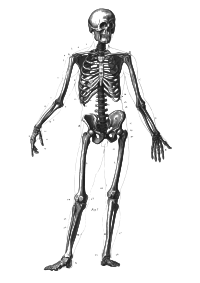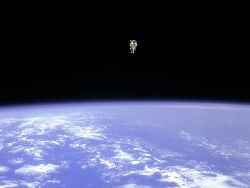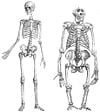| Human
| ||||||||||||||||
|---|---|---|---|---|---|---|---|---|---|---|---|---|---|---|---|---|
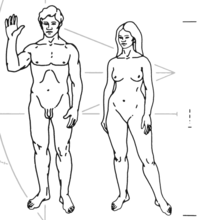 Humans as depicted on the Pioneer plaque
| ||||||||||||||||
| Scientific classification | ||||||||||||||||
| ||||||||||||||||
| Homo sapiens sapiens Linnaeus, 1758 |
In biological terms, a human being, or human, is any member of the mammalian species Homo sapiens, a group of ground-dwelling, tailless primates that are distributed worldwide and are characterized by bipedalism and the capacity for speech and language, with an erect body carriage that frees the hands for manipulating objects. Humans share with other primates the characteristics of opposing thumbs, omnivorous diet, five fingers (pentadactyl) with fingernails, and binocular, color vision. Humans are placed in the family Hominidae, which includes such apes as chimpanzees, gorillas, and orangutans, as well as including such close, extinct relatives as Australopithecus, Homo habilis, and Homo erectus.
However, human beings not only define themselves biologically and anatomically, but also in psychological, social, and spiritual terms.
Psychologically, humans have a highly developed brain capable of abstract reasoning, language, and introspection. Humans also are noted for their desire to understand and influence the world around them, seeking to explain and manipulate natural phenomena through science, philosophy, mythology, and religion. Humans also have a marked appreciation for beauty and aesthetics, and can use art, music, and literature to express concepts and feelings. Their mental capability, natural curiosity, and anatomy has allowed humans to develop advanced tools and skills; humans are the only known species to build fires, cook their food, clothe themselves, and use numerous other technologies.
Humans are inherently social animals, like most primates, but are particularly adept at utilizing systems of communication for self-expression, the exchange of ideas, and organization. They create complex social structures of cooperating and competing groups, ranging in scale from small families and partnerships to species-wide political, scientific, and economic unions, including complex systems of governance. Social interactions between humans have also established an extremely wide variety of traditions, rituals, ethics, values, social norms, and laws that form the basis of human society. Their ability to appreciate beauty and aesthetics, combined with the human desire for self-expression, has led to cultural innovations such as art, literature and music. Humans are notable for practicing altruistic behaviors not only towards relatives, but also others, including sometimes enemies and competitors. Males and females form monogamous pair bonds and raise their young in families where both parents protect and educate the youngsters. Humans have extended parental care, and pass on many attributes socially to their young.
Spiritually, humans have historically formed religious associations, characterized by belief in God, gods, or spirits, and by various traditions and rituals. Many religious perspectives emphasize soul, spirit, qi, or atman as the essence of a human being, with many holding that this inner essence survives the death of the physical body. For many, it is this inner essence that explains the unique psychological and social aspects of humans and is the principle characteristic differentiating humans from other animals.
Humans as primates
Humans are classified in the biological order Primates, a group of mammals containing all the species commonly related to the lemurs, monkeys, and apes. Primates are characterized by being anatomically unspecialized, with limbs capable of performing a variety of functions, refined five-digit hands adapted for grasping (including opposable thumbs), comparatively flattened snouts, and prolonged pre and postnatal development, among other features. All primates have five fingers (pentadactyl) that are long and inward closing, short fingernails (rather than claws), and a generalized dental pattern. While opposing thumbs are a characteristic primate feature, this feature is not limited to this order; opossums, for example, also have opposing thumbs. Primates are omnivorous (generalized feeders that consume both animal protein and vegetation).
Primates are informally arranged into three groups: (1) prosimians, (2) monkeys of the New World, and (3) monkeys and apes of the Old World. Humans belong to the third group of primates, and specifically those primates known as apes. Apes are those primates placed in the superfamily Hominoidea of the same clade Catarrhini; the Old World monkeys are placed in the superfamily Cercopithecoidea in the clade, or parvorder, Catarrhini. Apes consist of the various species of gibbons (or "lesser apes"), as well as gorillas, chimpanzees, bonobos, orangutans, and humans (collectively referred to as the "great apes").
From the point of view of superficial appearance, all living members of apes are tailless, while most Old World monkeys have tails. However, there are also primates in other families that lack tails. More specifically, the apes can be distinguished from the Old World monkeys by the number of cusps on their molars (apes have five—the "Y-5" molar pattern, Old World monkeys have only four in a "bilophodont" pattern). Apes have more mobile shoulder joints and arms, ribcages that are flatter front-to-back, and a shorter, less mobile spine compared to Old World monkeys.
A common taxonomic scheme divides the apes, or hominoids, into two families:
- The family Hylobatidae consists of 4 genera and 12 species of gibbons, collectively known as the "lesser apes"
- The family Hominidae consisting of gorillas, chimpanzees, orangutans, and humans, collectively known as the "great apes"
Members of the family Hominidae are called hominids by many systematists. Since recent classification schemes for the apes place extinct and extant humans, chimpanzees, gorillas, and orangutans in Hominidae, technically hominid refers to members of these groups. However, historically and even in some current classification schemes, Hominidae is restricted to humans and their close, extinct relatives—those more similar to humans than to the (other) great apes, which were placed in another family. Thus, there is a tradition, particularly in anthropology, of using the term hominid to refer only to humans and such forebears as Australopithecus, Homo habilis, and Homo erectus. In this sense, humans are considered the only surviving hominids.
Based on purely biological aspects (morphology, DNA, proteins, and so on), it is clear the humans are primates.
Indeed, humans and chimpanzees share more than 98 percent identity by various molecular comparisons (protein sequences, allele differences, DNA nucleotide sequences) (Wood 2006; King and Wilson 1975). Biologists believe that the two species of chimpanzees, Pan troglodytes and Pan paniscus, are the closest living evolutionary relatives to humans. The anatomical and biochemical similarity between chimpanzees and humans is so striking that some scientists even have proposed that the two chimpanzee species be placed with sapiens in the genus Homo, rather than in Pan. One argument for this suggested reclassification is that other species have been reclassified to belong to the same genus on the basis of less genetic similarity than that between humans and chimpanzees.
For example, Ebersberger et al. (2002) found a difference of only 1.24 percent when he aligned 1.9 million nucleotides of chimpanzee DNA and compared them with the corresponding human sequences in the human genome (Wood 2006). Using a 4.97 million nucleotide portion of DNA from human chromosome 7 and comparing to chimpanzee orthologies yielded only 1.13 percent mismatches (Liu et al. 2003). Likewise, a comparison of a rough draft of the chimpanzee genome—involving 361,782 contiguous fragments with a medium length of 15,700 nucleotides, covering about 94 percent of the chimpanzee genome—with the human genome, for those sequences that could be aligned, averaged 1.23 percent nucleotide mismatches (The Chimpanzee Sequencing and Analysis Consortium 2005). Comparison of chimpanzee exons and human sequences yielded only 0.6 to 0.87 percent differences (Wildman et al. 2003; Nielsen et al. 2005). For a more detailed discussion of this, see Chimpanzees and humans.
Uniqueness of human beings
Because humans are classified as primates and because apes are considered to be our biological ancestors, there is a modern tendency to consider humans as "just another primate" or "nothing but an animal." Indeed, the physical similarity between humans and other members of the "great apes" is so striking that efforts are underway to treat apes as "persons" with various human-like "rights." (See cultural aspects of non-human apes.)
However, despite the remarkable physical similarity, the gulf between humans and other great apes (and other animals in general) is qualitatively huge, in terms of cultural, psychological (including emotional and mental characteristics), and spiritual aspects. Humans have a complex language, use symbols in communication, write and read books, have set up diverse systems of governance, have remarkable self-awareness, conduct scientific experiments, practice religious traditions, have developed complex technologies, and so forth. As noted by eminent evolutionist Ernst Mayr, "Man is indeed unique, as different from all other animals, as has been traditionally claimed by theologians and philosophers" (Mayr 2001).
Language, involving syntax and grammar, is one notably unique characteristics of humans. Other animals species that sometimes are said to have a "language"—such as the "language of bees"—merely have systems of giving and receiving signals; they lack a system of communication with syntax and grammar, which is required to properly be a language (Mayr 2001, p. 253). Thus, chimpanzees, despite decades of attempts to teach them language, cannot talk about the future or the past; they seem to lack the ability to adopt syntax (Mayr 2001).
Other animals have intelligence and think, including highly developed intelligence in various mammals and birds (corvids, parrots, and so on) (Mayr 2001). But human intelligence is greater by orders of magnitude. Humans have self-awareness, can reason abstractly, are capable of introspection, and appreciate beauty and aesthetics. They desire to understand the world, including both past, present, and future, and even study other animals and themselves. They have developed complex systems of governance and law, established sciences, and express feelings through art, music, and literature. They have developed complex technologies.
Human beings, unlike any other animals, transfer a great deal of cultural information, utilizing language in the process. Many animals, such as most invertebrates, do not even have any relationship with their parents, which die before their are hatched, and thus the parents do not transmit information to their offspring. Humans, on the other hand, form monogamous pair bonds and have extensive parental care, raising their young in families where both parents educate the youngsters.
However, even in species with highly developed parental care, such as in certain mammals and birds, the amount of information that is handed down from generation to generation (nongenetic information transfer) is quite limited (Mayr 2001, 253). For humans, there is a great deal of information that is transferred. Unlike chimpanzee young, which become independent of their mothers within the first year of life, human young require many years to reach maturity, during which the parents transmit language, culture, and skills that make up the greater part of human personhood. Information is even transferred by the use of symbols, and in written languages in books.
Humans beings also practice altruism, not only for the benefit of an individual's own offspring, or the close relatives, or members of the same social group, but even towards outsiders and competitors or enemies. In chimpanzees, there is a practice of maiming or killing of former alpha males after they have been supplanted by a new leader. Human males, on the other hand, typically protect the children of other families of their tribe, and former male leaders are respected as honored elders. Respect for elderly males, codified in human morality as filial piety, is another means by which humans propagate and transmit culture.
Many religious hold that the most essential characteristic that makes humans unique is an immaterial essence: A soul, spirit, atman, qi, or so forth. It is this inner aspect that is considered to separate humans from animals. For example, there is a concept that humans have not only a physical body with physical senses, but also an immaterial or spiritual body with spiritual senses. This spiritual body is considered to mirror the appearance of the physical body, but also exists after the death of the material form. An example of such is found in the Bible: "It is sown a physical body, but it is raised a spiritual body. If there is a physical body, there is also a spiritual body" (1 Corinthians 15:44).
Thus, although there are close anatomical similarities between humans and other primates, particularly chimpanzees, the gap between humans and apes in terms of culture, mental capacity, and various spiritual, emotional, and technological aspects is so large as to dwarf differences between apes and other animals. In this sense, philosophers have recognized humans as distinct from animals generally.
The name Homo sapiens is Latin for "wise human" or "knowing human," emphasizing the importance of intelligence in separating humans and other animals. Mayr (2001) states that "it has long been appreciated that it is our brain that makes us human. Any other part of our anatomy can be matched or surpassed by a corresponding structure in some other animal." However, many theologians and philosophers would emphasize the inner aspects of humans as the most distinctive factor, or emphasize the essence of humans in the ability to love.
Biology
Genetics and physiology
See also: Human body
Humans are an eukaryotic species. Each diploid cell has two sets of 23 chromosomes, each set received from one parent. There are 22 pairs of autosomes and one pair of sex chromosomes. By present estimates, humans have approximately 20,000–25,000 genes. Like other mammals, humans have an XY sex-determination system, so that females have the sex chromosomes XX and males have XY. The X chromosome is larger and carries many genes not on the Y chromosome, which means that recessive diseases associated with X-linked genes, such as hemophilia, affect men more often than women.
Human body types vary substantially. Although body size is largely determined by genes, it is also significantly influenced by environmental factors such as diet and exercise. The average height of an adult human is about 5 to 6 feet (1.5 to 1.8 meters) tall, although this varies significantly from place to place (de Beer 2004). Humans are capable of fully bipedal locomotion, thus leaving their arms available for manipulating objects using their hands, aided especially by opposable thumbs.
Although humans appear relatively hairless compared to other primates, with notable hair growth occurring chiefly on the top of the head, underarms, and pubic area, the average human has more hair follicles on his or her body than the average chimpanzee. The main distinction is that human hairs are shorter, finer, and less heavily pigmented than the average chimpanzee's, thus making them harder to see (Wade 2003).
Skin color, hair color, and "races"

The hue of human hair and skin is determined by the presence of pigments called melanins. Human skin hues can range from very dark brown to very pale pink, while human hair ranges from blond to brown to red to, most commonly, black (Rogers et al. 2004).
The differences in skin color between various people is due to one type of cell, the melanocyte. The number of melanocytes in human skin is believed to be the same for all people. However, the amount of pigment, or melanin, within the melanocytes is different. People with black skin have the most pigment and people with white skin have the least amount of pigment (Astner and Anderson 2004).
Many researchers believe that skin darkening was an adaptation that evolved as a protection against ultraviolet solar radiation, as melanin is an effective sun-block (Jablonski and Chaplin 2000). The skin pigmentation of contemporary humans is geographically stratified, and in general correlates with the level of ultraviolet radiation. Human skin also has a capacity to darken (sun tanning) in response to exposure to ultraviolet radiation (Harding et al. 2000; Robins 1991).
Historically, efforts have been made to designate various human populations as distinct "races" based on skin color, along with such other observable physical traits as hair type, facial features, and body proportions. However, today many scientists from diverse fields, such as genetics, physical anthropology, sociology, and biology, believe that the concept of distinct human races is unscientific and that there are no distinct races as previously claimed (O'Campo 2005; Keita et al. 2004). The concept of "race" is a valid taxonomic concept in other species. However, in humans only a small proportion of the genetic variability of humans occurs between so-called races, there is much greater variability among members of a race than between members of different races, and racial traits overlap without discrete boundaries—making genetic differences among groups biologically meaningless (O'Campo 2005; Schwartz and Vissing 2002; Smedley and Smedley 2005; Lewontin 1972). In addition, so-called races are freely interbreeding. On the other hand, other geneticists argue that categories of self-identified race/ethnicity or biogeographic ancestry are both valid and useful (Risch et al. 2002; Bamshad 2005), and that arguments against delineating races could also be made regarding making distinctions based on age or sex (Risch et al. 2002).
Rather than delineating races, there is a current tendency to identify ethnic groups, with members defined by shared geographical origin or cultural history, such as common language and religion (O'Campo 2005), and there is a tendency to recognize a graded serious of differences (a cline) along geographical or environmental ranges.
The recognition of different races, along with preferences toward particular groups, or exploitation or domination of other groups, is sometimes identified with the term racism. From a biological point of view, in which species are recognized as actually or potentially interbreeding natural populations, one might define someone as a "racist" on the basis of whether the person is willing to marry, and to have their children marry, someone of any other "race." From a biblical point of view, all people are descended from one common pair of ancestors (O'Campo 2005).
From the point of view of some religions, the essential part of humans is the soul, which counters a fixation on physiology and observable physical characteristics alone (O'Campo 2005).
Life cycle

The human life cycle is similar to that of other placental mammals. New humans develop viviparously (live birth) from fertilization of an egg by a sperm (conception). An egg is usually fertilized inside the female by sperm from the male through sexual intercourse, though the recent technology of in vitro fertilization is occasionally used.
The fertilized egg, called a zygote, divides inside the female's uterus to become an embryo that is implanted on the uterine wall. The fetal stage of prenatal development (fetus) begins about seven or eight weeks after fertilization, when the major structures and organ systems have formed, until birth. After about nine months of gestation, the fully-grown fetus is expelled from the female's body and breathes independently as a "neonate" or infant for the first time. At this point, most modern cultures recognize the baby as a person entitled to the full protection of the law, though some jurisdictions extend personhood to human fetuses while they remain in the uterus.
Compared with that of other species, human childbirth can be dangerous. Painful labors lasting twenty-four hours or more are not uncommon, and may result in injury, or even death, to the child and/or mother. This is because of both the relatively large fetal head circumference (for housing the brain) and the mother's relatively narrow pelvis (a trait required for successful bipedalism (LaVelle 1995; Correia et al. 2005). The chances of a successful labor increased significantly during the 20th century in wealthier countries with the advent of new medical technologies. In contrast, pregnancy and natural childbirth remain relatively hazardous ordeals in developing regions of the world, with maternal death rates approximately 100 times more common than in developed countries (Rush 2000).
In developed countries, infants are typically 3–4 kilograms (6–9 pounds) in weight and 50–60 centimeters (20–24 inches) in height at birth. However, low birth weight is common in developing countries, and contributes to the high levels of infant mortality in these regions (Khor 2003).
Helpless at birth, humans continue to grow for some years, typically reaching sexual maturity at 12 to 15 years of age. Human girls continue to grow physically until around the age of 18, and human boys until around age 21. The human life span can be split into a number of stages: infancy, childhood, adolescence, young adulthood, adulthood, and old age. The lengths of these stages, however, are not fixed, and particularly the later stages.
There are striking differences in life expectancy around the world, ranging from as high as over 80 years to less than 40 years.
The number of centenarians (humans of age 100 years or older) in the world was estimated at nearly half a million 2015 (Stepler 2016). At least one person, Jeanne Calment, is known to have reached the age of 122 years; higher ages have been claimed but they are not well substantiated. Worldwide, there are 81 men aged 60 or older for every 100 women of that age group, and among the oldest, there are 53 men for every 100 women.
The philosophical questions of when human personhood begins and whether it persists after death are the subject of considerable debate. The prospect of death causes unease or fear for most humans. Burial ceremonies are characteristic of human societies, often accompanied by beliefs in an afterlife or immortality.
Diet
Early Homo sapiens employed a "hunter-gatherer" method as their primary means of food collection, involving combining stationary plant and fungal food sources (such as fruits, grains, tubers, and mushrooms) with wild game, which must be hunted and killed in order to be consumed. It is believed that humans have used fire to prepare and cook food prior to eating since possibly the time of Homo erectus.
Humans are omnivorous, capable of consuming both plant and animal products. The view of humans as omnivores is supported by the evidence that both a pure animal and a pure vegetable diet can lead to deficiency diseases in humans. A pure animal diet can, for instance, lead to scurvy, while a pure plant diet can lead to deficiency of a number of nutrients, including Vitamin B12. Some humans have chosen to abstain from eating some or all meat for religious, ethical, ecological, or health reasons. Supplementation, particularly for vitamin B12, is highly recommended for people living on a pure plant diet.
The human diet is prominently reflected in human culture, and has led to the development of food science.
In general, humans can survive for two to eight weeks without food, depending on stored body fat. Survival without water is usually limited to three or four days, but longer periods are known, including fasting for religious purposes.
Lack of food remains a serious global problem, with about 300,000 people starving to death every year. Childhood malnutrition is also common and contributes to the global burden of disease (Murray and Lopez 1997). However global food distribution is not even, and obesity among some human populations has increased to almost epidemic proportions, leading to health complications and increased mortality in some developed, and a few developing countries. Obesity is caused by consuming more calories than are expended, with many attributing excessive weight gain to a combination of overeating and insufficient exercise.
At least ten thousand years ago, humans developed agriculture (see rise of civilization below), which has substantially altered the kind of food people eat. This has led to increased populations, the development of cities, and because of increased population density, the wider spread of infectious diseases. The types of food consumed, and the way in which they are prepared, has varied widely by time, location, and culture.
History
Origin of Homo sapiens sapiens (modern humans)
- For more details on this topic, see Human evolution.
The scientific study of human evolution concerns the emergence of humans as a distinct species. It encompasses the development of the genus Homo, as well as studying extinct human ancestors, such as the australopithecines, and even chimpanzees (genus Pan), which are usually classified together with genus Homo in the tribe Hominini. "Modern humans" are defined as the Homo sapiens species, of which the only extant subspecies is Homo sapiens sapiens.
There is substantial evidence for a primate origin of humans (Mayr 2001):
- Anatomical evidence: Human beings exhibit close anatomical similarities with the African apes, and particularly the chimpanzee. Compared to apes, the few unique physical characteristics of humans are the proportion of arms and legs, opposable thumbs, body hair, skin pigmentation, and size of the central nervous system, such as the forebrain.
- Fossil evidence: Numerous fossils have been found sharing human and primate characteristics.
- Molecular evidence: Human molecules are very similar to that of chimpanzees. In some, such as hemoglobin, they are virtually identical.
The closest living relatives of Homo sapiens are two distinct species of the genus Pan: the bonobo (Pan paniscus) and the common chimpanzee (Pan troglodytes). Through a study of proteins, comparison of DNA, and use of a molecular clock (a method of calculating evolution based on the speed at which genes mutate), scientists believe thePan/Homo split happened about 5 to 8 million years ago (Mayr 2001, Physorg 2005). (See Pan/Homo split.)
Well-known members of the Homo genus include Homo habilis (about 2.4 to 1.5 mya), Homo erectus (1.8 mya to 70,000 years ago), Homo heidelbergensis (800,000 to 300,000 years ago), and Homo neanderthalensis (250,000 to 30,000 years ago).
H. sapiens have lived from about 250,000 years ago to the present. Between 400,000 years ago and the second interglacial period in the Middle Pleistocene, around 250,000 years ago, the trend in cranial expansion and the elaboration of stone tool technologies developed, providing evidence for a transition from H. erectus to H. sapiens. Based on molecular evidence, the calculation of the time of divergence of all modern human populations from a common ancestor typically yields dates around 200,000 years (Disotell 1999).
Notably, however, about 50,000 to 40,000 years ago, human beings appeared to have taken a Great Leap Forward, when human culture apparently changed at a much greater speed. Humans started to bury their dead carefully, made clothing out of hides, developed sophisticated hunting techniques (such as pitfall traps, or driving animals to fall off cliffs), and made cave paintings. Additionally, human culture began to become more technologically advanced, in that different populations of humans begin to create novelty in existing technologies. Artifacts such as fish hooks, buttons, and bone needles begin to show signs of variation among different population of humans, something what had not been seen in human cultures prior to 50,000 BP. This "Great Leap Forward" seems connected to the arrival of modern humans beings: Homo sapiens sapiens. (See modern man and the great leap forward.)
The Cro-Magnons form the earliest known European examples of Homo sapiens sapiens. The term falls outside the usual naming conventions for early humans and is used in a general sense to describe the oldest modern people in Europe. Cro-Magnons lived from about 40,000 to 10,000 years ago in the Upper Paleolithic period of the Pleistocene epoch. For all intents and purposes these people were anatomically modern, only differing from their modern day descendants in Europe by their slightly more robust physiology and larger brain capacity than that of modern humans. When they arrived in Europe about 40,000 years ago, they brought with them sculpture, engraving, painting, body ornamentation, music, and the painstaking decoration of utilitarian objects.
Current research establishes that human beings are highly genetically homogeneous, meaning that the DNA of individual Homo sapiens is more alike than usual for most species. Geneticists Lynn Jorde and Henry Harpending of the University of Utah, noting that the variation in human DNA is minute compared to that of other species, propose that during the Late Pleistocene, the human population was reduced to a small number of breeding pairs—no more than 10,000 and possibly as few as 1,000—resulting in a very small residual gene pool. Various reasons for this hypothetical bottleneck have been postulated, one of those is the Toba catastrophe theory.
There are two major scientific challenges in deducing the pattern of human evolution. For one, the fossil record remains fragmentary. Mayr (2001) notes that no fossils of hominids have been found for the period between 6 and 13 million years ago (mya), the time when branching between the chimpanzee and human lineages is expected to have taken place. Furthermore, as Mayr notes, "most hominid fossils are extremely incomplete. They may consist of part of a mandible, or the upper part of a skull without face and teeth, or only part of the extremities." Coupled with this is a recurrent problem that interpretation of fossil evidence is heavily influenced by personal beliefs and prejudices. Fossil evidence often allows a variety of interpretations, since the individual specimens may be reconstructed in a variety of ways (Wells 2000).
There are two dominant, and one might say polarizing, general views on the issue of human origins, the Out of Africa position and the multiregional position.
The Out of Africa, or Out of Africa II, or replacement model holds that after there was a migration of Homo erectus (or H. ergaster) out of Africa and into Europe and Asia, these populations did not subsequently contribute significant amounts of genetic material (or, some say, contributed absolutely nothing) to later populations along the lineage to Homo sapiens (Ruse and Travis 2009). Later, approximately 200,000 years ago, there was a second migration of hominids out of Africa, and this was modern H. sapiens that replaced the populations that then occupied Europe and Asia (Ruse and Travis 2009). This view maintains a specific speciation event that led to H. sapiens in Africa, and this is the modern human.
The multiregional or continuity camp hold that since the origin of H. erectus, there have been populations of hominids living in the Old World and that these all contributed to successive generations in their regions (Ruse and Travis 2009). According to this view, hominids in China and Indonesia are the most direct ancestors of modern East Asians, those in Africa are the most direct ancestors of modern Africans, and the European populations either gave rise to modern Europeans or contributed significant genetic material to them, while their origins were in Africa or West Asia (Ruse and Travis 2009). There is genetic flow to allow for the maintenance of one species, but not enough to prevent racial differentiation.
There are various combinations of these ideas.
Overall, human evolution theory comprises two principal theories: Those related to the pattern of evolution and those related to the process of evolution. The theory of descent with modification addresses the pattern of evolution, and as applied to humans the theory is strongly supported by the fossil record, which provides evidence of skeletons that through time become more and more like the modern human skeleton. In contrast, the theory of natural selection, which relates to the process of evolution is intrinsically more speculative as it relates to presumed causes.
Substantial evidence has been marshaled for the fact that humans have descended from common ancestors by a process of branching (descent with modification) and for a primate origin of humans. However, proposals for the specific ancestral-descendant relationships and for the process leading to humans tend to be speculative. And, while the theory of natural selection typically is central to scientific explanations for the process, evidence for natural selection being the directive or creative force is limited to extrapolation from the microevolutionary level (changes within the level of species). Historically, a major source of controversy has been the process by which humans have developed, whether by physical forces with an exclusively random component (natural selection) or by the creative force of a Creator God. (Abrahamic religions believe that modern humans derive from an original couple Adam and Eve into whose material bodies God breathed spiritual life (added a spirit or soul) to complete the creation of a being uniquely different from animals.)
Rise of civilization
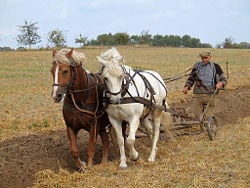
Up until only around 10,000 years ago, all humans lived as hunter-gatherers (with some communities persisting until this day). They generally lived in small, nomadic groups. The advent of agriculture prompted the Neolithic Revolution. Developed independently by geographically distant populations, evidence suggests that agriculture first appeared in Southwest Asia, in the Fertile Crescent. Around 9500 B.C.E., farmers first began to select and cultivate food plants with specific characteristics. Though there is evidence of earlier use of wild cereals, it was not until after 9500 B.C.E. that the eight so-called Neolithic founder crops of agriculture appeared: first emmer wheat and einkorn wheat, then hulled barley, peas, lentils, bitter vetch, chick peas, and flax. By 7000 B.C.E., sowing and harvesting reached Mesopotamia. By 6000 B.C.E., farming was entrenched on the banks of the Nile River. About this time, agriculture was developed independently in the Far East, with rice, rather than wheat, the primary crop.
Access to food surplus led to the formation of permanent human settlements, the domestication of animals, and the use of metal tools. Agriculture also encouraged trade and cooperation, leading to complex societies. Villages developed into thriving civilizations in regions such as the Middle East's Fertile Crescent.
Around 6,000 years ago, the first proto-states developed in Mesopotamia, Egypt, and the Indus Valley. Military forces were formed for protection and government bureaucracies for administration. States cooperated and competed for resources, in some cases waging wars. Around 2,000–3,000 years ago, some states, such as Persia, China, and Rome, developed through conquest into the first expansive empires. Influential religions, such as Judaism, originating in the Middle East, and Hinduism, a religious tradition that originated in South Asia, also rose to prominence at this time.
The late Middle Ages saw the rise of revolutionary ideas and technologies. In China, an advanced and urbanized economy promoted innovations such as printing and the compass, while the Islamic Golden Age saw major scientific advancements in Muslim empires. In Europe, the rediscovery of classical learning and inventions such as the printing press led to the Renaissance in the fourteenth century. Over the next 500 years, exploration and imperialistic conquest brought much of the Americas, Asia, and Africa under European control, leading to later struggles for independence.
The Scientific Revolution in the seventeenth century and the Industrial Revolution in the eighteenth-nineteenth centuries promoted major innovations in transport, such as the railway and automobile; energy development, such as coal and electricity; and government, such as representative democracy and Communism.
As a result of such changes, modern humans live in a world that has become increasingly globalized and interconnected. Although this has encouraged the growth of science, art, and technology, it has also led to culture clashes, the development and use of weapons of mass destruction, and increased environmental destruction and pollution.
Habitat and population
Early human settlements were dependent on proximity to water and, depending on the lifestyle, other natural resources, such as fertile land for growing crops and grazing livestock, or populations of prey for hunting. However, humans have a great capacity for altering their habitats by various methods, such as through irrigation, urban planning, construction, transport, and manufacturing goods. With the advent of large-scale trade and transport infrastructure, proximity to these resources has become unnecessary, and in many places these factors are no longer a driving force behind the growth and decline of a population. Nonetheless, the manner in which a habitat is altered is often a major determinant in population change.
Technology has allowed humans to colonize all of the continents and adapt to all climates. Within the last few decades, humans have explored Antarctica, the ocean depths, and space, although long-term habitation of these environments is not yet possible.
With a population of over seven billion, humans are among the most numerous of the large mammals. Most humans (61 percent) live in Asia. The vast majority of the remainder live in the Americas (14 percent), Africa (13 percent), and Europe (12 percent), with 0.5 percent in Oceania.
Human habitation within closed ecological systems in hostile environments, such as Antarctica and outer space, is expensive, typically limited in duration, and restricted to scientific, military, or industrial expeditions. Life in space has been very sporadic, with no more than thirteen humans in space at any given time. Between 1969 and 1972, two humans at a time spent brief intervals on the Moon. As of 2007, no other celestial body has been visited by human beings, although there has been a continuous human presence in outer space since the launch of the initial crew to inhabit the International Space Station on October 31, 2000; however, humans have made robots that have visited other celestial bodies.
From 1800 to 2012 C.E., the human population increased from one billion to seven billion. In 2004, around 2.5 billion out of 6.3 billion people (39.7 percent) lived in urban areas, and this percentage is expected to rise throughout the twenty-first century. Problems for humans living in cities include various forms of pollution and crime, especially in inner city and suburban slums. Benefits of urban living include increased literacy, access to the global canon of human knowledge, and decreased susceptibility to rural famines.
Humans have had a dramatic effect on the environment. The extinction of a number of species has been attributed to anthropogenic factors, such as human predation and habitat loss, and other negative impacts include pollution, widespread loss of wetlands and other ecosystems, alteration of rivers, and introduction of invasive species. On the other hand, humans in the past century have made considerable efforts to reduce negative impacts and provide greater protection for the environment and other living organisms, through such means as environmental law, environmental education, and economic incentives.
Psychology
The brain is a centralized mass of nerve tissue enclosed within the cranium (skull) of vertebrates. The human brain is the center of the central nervous system in humans, as well as the primary control center for the peripheral nervous system. The brain controls "lower," or involuntary, autonomic activities such as the respiration, and digestion. The brain also is critical to "higher" order, conscious activities, such as thought, reasoning, and abstraction (PBS 2005). Mayr (2001) states that the human brain "seems not to have changed one single bit since the first appearance of Homo sapiens some 150,000 years ago."
A central issue in philosophy and religion is how the brain relates to the mind. The brain is defined as the physical and biological matter contained within the skull, responsible for all electrochemical neuronal processes. The mind, however, is seen in terms of mental attributes, such as beliefs or desires. Mind is a concept developed by self-conscious humans trying to understand what is the self that is conscious and how does that self relate to its perceived world. Most broadly, mind is the organized totality of the mental processes of an organism and the structural and functional components on which they depend. Taken more narrowly, as it often is in scientific studies, mind denotes only cognitive activities and functions, such as perceiving, attending, thinking, problem solving, language, learning, and memory (VandenBos 2007).
Philosophers have long sought to understand what is mind and its relationship to matter and the body. There is a concept, tracing back at least to Plato, Aristotle, and the Sankhya and Yoga schools of Hindu philosophy, that "mental" phenomena are, in some respects, "non-physical" (distinct from the body). For example, Saint Thomas Aquinas identified a person as being the composite substance of body and soul (or mind), with soul giving form to body. Christian views after Aquinas have diverged to cover a wide spectrum, but generally they tend to focus on soul instead of mind, with soul referring to an immaterial essence and core of human identity and to the seat of reason, will, conscience, and higher emotions. Rene Descartes established the clear mind-body dualism that has dominated the thought of the modern West. He introduced two assertions: First, that mind and soul are the same and that henceforth he would use the term mind and dispense with the term soul; Second, that mind and body were two distinct substances, one immaterial and one material, and the two existed independent of each other except for one point of interaction in the human brain.
As psychology became a science starting in the late nineteenth century and blossomed into a major scientific discipline in the twentieth century, the prevailing view in the scientific community came to be variants of physicalism with the assumption that all the functions attributed to mind are in one way or another derivative from activities of the brain. Countering this mainstream view, a small group of neuroscientists has persisted in searching for evidence suggesting the possibility of a human mind existing and operating apart from the brain.
In the late twentieth century, as diverse technologies related to studying the mind and body have been steadily improved, evidence has emerged suggesting such radical concepts as: The mind should be associated not only with the brain but with the whole body; and the heart may be a center of consciousness complementing the brain. Some envision a physical mind that mirrors the physical body, guiding its instinctual activities and development, while adding the concept for humans of a spiritual mind that mirrors a spiritual body and including aspects like philosophical and religious thought.
The human brain is generally regarded as more capable of the various higher order activities, and more "intelligent" in general, than that of any other species. While other animals are capable of creating structures and using simple tools—mostly as a result of instinct and learning through mimicry—human technology is vastly more complex, constantly evolving and improving with time. Even the most ancient human tools and structures are far more advanced than any structure or tool created by any other animal (Sagan 1978).
Consciousness and thought
- For more details on this topic, see Consciousness and Cognition.
The human ability to think abstractly may be unparalleled in the animal kingdom. Humans are one of only six groups of animals to pass the mirror test—which tests whether an animal recognizes its reflection as an image of itself—along with chimpanzees, orangutans, dolphins, and possibly pigeons. In October 2006, three elephants at the Bronx Zoo also passed this test (Plotnik et al. 2006). Humans under the age of 2 typically fail this test (Palmer 2006). However, this may be a matter of degree rather than a sharp divide. Monkeys have been trained to apply abstract rules in tasks (Coveney 2001).
The brain perceives the external world through the senses, and each individual human is influenced greatly by his or her experiences, leading to subjective views of existence and the passage of time.
Humans are variously said to possess consciousness, self-awareness, and a mind, which correspond roughly to the mental processes of thought. These are said to possess qualities such as self-awareness, sentience, sapience, and the ability to perceive the relationship between oneself and one's environment. The extent to which the mind constructs or experiences the outer world is a matter of debate, as are the definitions and validity of many of the terms used above. The philosopher of cognitive science Daniel Dennett, for example, argues that there is no such thing as a narrative center called the "mind," but that instead there is simply a collection of sensory inputs and outputs: Different kinds of "software" running in parallel (Dennett 1991).
Humans study the more physical aspects of the mind and brain, and by extension of the nervous system, in the field of neurology, the more behavioral in the field of psychology, and a sometimes loosely-defined area between in the field of psychiatry, which treats mental illness and behavioral disorders. Psychology does not necessarily refer to the brain or nervous system, and can be framed purely in terms of phenomenological or information processing theories of the mind. Increasingly, however, an understanding of brain functions is being included in psychological theory and practice, particularly in areas such as artificial intelligence, neuropsychology, and cognitive neuroscience.
The nature of thought is central to psychology and related fields. Cognitive psychology studies cognition, the mental processes underlying behavior. It uses information processing as a framework for understanding the mind. Perception, learning, problem solving, memory, attention, language, and emotion are all well-researched areas as well. Cognitive psychology is associated with a school of thought known as cognitivism, whose adherents argue for an information processing model of mental function, informed by positivism and experimental psychology. Techniques and models from cognitive psychology are widely applied and form the mainstay of psychological theories in many areas of both research and applied psychology. Largely focusing on the development of the human mind through the life span, developmental psychology seeks to understand how people come to perceive, understand, and act within the world and how these processes change as they age. This may focus on intellectual, cognitive, neural, social, or moral development.
Some philosophers divide consciousness into phenomenal consciousness, which is experience itself, and access consciousness, which is the processing of the things in experience (Block 1995). Phenomenal consciousness is the state of being conscious, such as when they say "I am conscious." Access consciousness is being conscious of something in relation to abstract concepts, such as when one says "I am conscious of these words." Various forms of access consciousness include awareness, self-awareness, conscience, stream of consciousness, Husserl's phenomenology, and intentionality. The concept of phenomenal consciousness, in modern history, according to some, is closely related to the concept of qualia.
Social psychology links sociology with psychology in their shared study of the nature and causes of human social interaction, with an emphasis on how people think towards each other and how they relate to each other. The behavior and mental processes, both human and non-human, can be described through animal cognition, ethology, evolutionary psychology, and comparative psychology as well. Human ecology is an academic discipline that investigates how humans and human societies interact with both their natural environment and the human social environment.
Comparison to other species
Theories in psychology, like the construction of the ego as suggested in the mirror stage by Jacques Lacan, reminds us about the possibility that self-consciouness and self-reflection may be at least in part a human construction. Various attempts have been made to identify a single behavioral characteristic that distinguishes humans from all other animals. Some anthropologists think that readily observable characteristics (tool-making and language) are based on less easily observable mental processes that might be unique among humans: The ability to think symbolically, in the abstract or logically, although several species have demonstrated some abilities in these areas. Nor is it clear at what point exactly in human evolution these traits became prevalent. They may not be restricted to the species Homo sapiens, as the extinct species of the Homo genus (for example, Homo neanderthalensis, Homo erectus) are believed to also have been adept tool makers and may also have had linguistic skills.
Motivation and emotion

- For more details on this topic, see Motivation and Emotion.
Motivation is the driving force of desire behind all deliberate actions of human beings. Motivation is based on emotion, such as the search for satisfaction (positive emotional experiences), and the avoidance of conflict. Positive and negative is defined by the individual brain state, which may be influenced by social norms: a person may be driven to self-injury or violence because their brain is conditioned to create a positive response to these actions. Motivation is important because it is involved in the performance of all learned responses.
Within psychology, conflict avoidance and the libido are seen to be primary motivators. Within economics, motivation is often seen to be based on financial incentives, moral incentives, or coercive incentives. Religions generally posit divine or demonic influences.
Happiness, or being happy, is a human emotional condition. The definition of happiness is a common philosophical topic. Some people might define it as the best condition that a human can have—a condition of mental and physical health. Others may define it as freedom from want and distress; consciousness of the good order of things; assurance of one's place in the universe or society, inner peace, and so forth.
Human emotion has a significant influence on, or can even be said to control, human behavior, though historically many cultures and philosophers have for various reasons discouraged allowing this influence to go unchecked.
Emotional experiences perceived as pleasant, like love, admiration, or joy, contrast with those perceived as unpleasant, like hate, envy, or sorrow. There is often a distinction seen between refined emotions, which are socially learned, and survival oriented emotions, which are thought to be innate.
Human exploration of emotions as separate from other neurological phenomena is worthy of note, particularly in those cultures where emotion is considered separate from physiological state. In some cultural medical theories, to provide an example, emotion is considered so synonymous with certain forms of physical health that no difference is thought to exist. The Stoics believed excessive emotion was harmful, while some Sufi teachers (in particular, the poet and astronomer Omar Khayyám) felt certain extreme emotions could yield a conceptual perfection, what is often translated as ecstasy.
In modern scientific thought, certain refined emotions are considered to be a complex neural trait of many domesticated and a few non-domesticated mammals. These were commonly developed in reaction to superior survival mechanisms and intelligent interaction with each other and the environment; as such, refined emotion is not in all cases as discrete and separate from natural neural function as was once assumed. Still, when humans function in civilized tandem, it has been noted that uninhibited acting on extreme emotion can lead to social disorder and crime.
Love and sexuality
- For more details on this topic, see Love and Human sexuality.
Humans are known for forming monogamous pair bonds and for extensive parental care, establishing families of parents and children. They also are known for relationships based on "love."
Love is any of a number of emotions and experiences related to a sense of strong affection or profound oneness. Depending on context, love can have a wide variety of intended meanings, including sexual attraction. Psychologists and religious teachings, however, define love more precisely, as living for the sake of another, motivated by heart-felt feelings of caring, affection, and responsibility for the other's well-being.
Perhaps the best context in which to develop such love is the family, where the love that is given and received is of various kinds. Love can involve the sacrifice and investment that parents willingly give on behalf of their children, and children, in turn, can offer their parents filial devotion and respect. Siblings can care for and help one another in various ways. The love between spouses is a world in itself. Grandparents typically bear a profound regard for their grandchildren. All of these types of love have their distinctive features.
Although love is universally desired, it can be fraught with infidelity, deceit, possessiveness, unrealistic expectations, jealousy, and hate. Love, in fact, is at the root of much pain and conflict in the world. Marriages break down when the passion of romance cools.
Human sexuality refers to the expression of sexual sensation and related intimacy between human beings. Biologically, it is the means through which a child is conceived and the lineage is passed on to the next generation. However, besides ensuring biological reproduction, human sexuality has important social functions: It creates physical intimacy, bonds, and hierarchies among individuals; may be directed to spiritual transcendence (according to some traditions); and in a hedonistic sense to the enjoyment of activity involving sexual gratification. Psychologically, sexuality is the means to express the fullness of love between a man and a woman.
There are a great many forms of human sexuality, comprising a broad range of behaviors, and sexual expression varies across cultures and historical periods. Yet the basic principles of human sexuality are universal and integral to what it means to be human. Sex is related to the very purposes of human existence: love, procreation, and family. Sexuality has social ramifications; therefore most societies set limits, through social norms and taboos, moral and religious guidelines, and legal constraints on what is permissible sexual behavior.
As with other human self-descriptions, humans propose that it is high intelligence and complex societies of humans that have produced the most complex sexual behaviors of any animal, including a great many behaviors that are not directly connected with reproduction.
Some scientists and layman hold that human sexuality is not innately monogamous nor by nature exclusively heterosexual (between a man and a woman). For example, Alfred Kinsey, a sex researcher, speculates that people can fall anywhere along a continuous scale of sexual orientation, with only small minorities fully heterosexual or homosexual), while other scientists speculate based on neurology and genetics that people may be born with one sexual orientation or another (Buss 2003; Thornhill and Palmer 2000). Social Darwinism has been used in speculating that it is the natural state of human beings for males to be promiscuous in order to try to widely spread their genes, while females are naturally monogamous, seeking a stable male presence to help during pregnancy and in rearing children given the extensive parental care involved—a concern about reproduction from which women have been freed recently by various forms of contraception.
However, there are a wide body of authorities likewise who maintain that humans are by nature monogamous and heterosexual, as seen in the tradition of pair bonding and families throughout history. For example, the world's major religions concur in viewing sexual intimacy as proper only within marriage; otherwise, it can be destructive to human flourishing. A common religious perspective is to view promiscuous and non-heterosexual behavior as deviating from the original human nature, and in Christianity such behaviors traditionally are seen as sin that are tied to separation from God—a separation epitomized in the Fall of Man. In psychology, homosexuality was listed for some time as a psychological disorder, although this has fallen into disfavor, and marriage counselors strive to find ways to strengthen marriage and love rather than promote promiscuity. From a more medical point of view, promiscuity is linked to various sexually transmitted diseases and even greater incidents of some forms of cancer, leading to the speculation that it is not an advantageous state for humans.
The rationale for traditional moral strictures on sexuality, in general, is that a sexual activity can express committed love or be a meaningless casual event for recreational purposes. Yet sexual encounters are not merely a physical activity like enjoying good food. Sex involves the partners in their totality, touching their minds and hearts as well as their bodies. Therefore, sexual relations have lasting impact on the psyche. Sexuality is a powerful force that can do tremendous good or terrible harm; therefore it carries with it moral responsibility.
Culture
- For more details on this topic, see Culture.
Culture is defined here as a set of distinctive material, intellectual, emotional, and spiritual features of a social group, including art, literature, value systems, traditions, rituals, lifestyles, and beliefs. The link between human biology and human behavior and culture is often very close, making it difficult to clearly divide topics into one area or the other; as such, the placement of some subjects may be based primarily on convention.
Culture consists of values, social norms, and artifacts. A culture's values define what it holds to be important or ethical. Closely linked are norms, expectations of how people ought to behave, bound by tradition. Artifacts, or "material culture," are objects derived from the culture's values, norms, and understanding of the world.
The mainstream anthropological view of "culture" implies that most people experience a strong resistance when reminded that there is an animal as well as a spiritual aspect to human nature (Benthall 2007).
Language
- For more details on this topic, see Language.
The capacity humans have to transfer concepts, ideas, and notions through speech and writing is unrivaled in known species. The faculty of speech is a defining feature of humanity, possibly predating phylogenetic separation of the modern population. Language is central to the communication between humans, as well as being central to the sense of identity that unites nations, cultures, and ethnic groups.
The invention of writing systems about 5000 years ago allowed the preservation of language on material objects, and was a major step in cultural evolution. Language is closely tied to ritual and religion (cf. mantra, sacred text).
The science of linguistics describes the structure of language and the relationship between languages. There are approximately 6,000 different languages currently in use, including sign languages, and many thousands more that are considered extinct.
Human self reflection leads to the understanding of the origins of human beings.
Prehistoric notions about the status of humanity may be guessed by the etymology of ancient words for man. Latin homo (PIE *kþonyon) means "of the earth, earthling," probably in opposition to "celestial" beings. Greek ἂνθροπος (mycenaean *anthrokwos) means "low-eyed," again probably contrasting with a divine perspective.
Ancient Orient. From the third millennium B.C.E. Old Kingdom of Egypt, belief in the eternal afterlife of the human Ka (Egyptian soul) is documented. From the earliest times, people made a claim of dominance of humanity alongside radical pessimism because of the frailty and brevity of human life (In the Hebrew Bible, for example, dominion of man is promised in Genesis 1:28, but the author of Ecclesiastes bewails the vanity of all human effort).
Classical antiquity. Protagoras made the famous claim that, "Man is the measure of all things; of what is, that it is; of what is not, that it is not." Socrates gave the (doubtlessly tongue-in-cheek) definition of humans as "featherless bipeds" (Plato, Politicus). More serious is Aristotle's description of the human as the "communal animal" (ζώον πολιτκόν), in other words, emphasizing society-building as a central trait of human nature, and "animal with sapience" (ζώον λόγoν ἒχων, animal rationale), a term that also inspired the species' taxonomy, Homo sapiens.
Middle Ages. The dominant worldview of medieval Europe, as guided by the Catholic Church, was that human existence is characterized by sin, and that its aim should be to prepare for divine judgment after death. The thirteenth century pope Innocent III wrote about the essential misery of earthly existence in his "On the misery of the human condition"—a view that was disputed by, for example, Gianozzo Manetti in his treatise, "On human dignity."
Renaissance. A famous quote of Shakespeare's Hamlet (II, ii, 115-117), expressing the contrast of human physical beauty, intellectual faculty, and ephemeral nature: "What a piece of work is a man! How noble in reason! how infinite in faculties! in form and moving, how express and admirable! in action how like an angel! in apprehension, how like a god! the beauty of the world! the paragon of animals! And yet, to me, what is this quintessence of dust?"
Modern era. The Enlightenment was driven by a renewed conviction, that, in the words of Immanuel Kant, "Man is distinguished above all animals by his self-consciousness, by which he is a 'rational animal'." In the nineteenth century, Karl Marx defined man as "laboring animal" (animal laborans) in conscious opposition to this tradition. In the early twentieth century, Sigmund Freud countered positivism by postulating that human behavior is to a large part controlled by the unconscious mind.
Some feel that the modern culture of materialism leaves little room for reflection; the tendency to focus on worldly goods naturally denies the opportunity to ponder one's life and its place in the universe. The idea of philosophy being discarded as it runs counter to the pursuit of pleasure is a common theme in certain works of dystopian science fiction, such as Brave New World or Fahrenheit 451.
However, it could be argued that a culture of self obsession leads to more self-reflection, since, in the quest for the ideal life, individuals will constantly analyze their characters, faults, and ambitions. This can be shown in the trend to seek psychotherapy as the panacea to one's emotional woes. The current popularity of the Humanities among the academic disciplines also shows an increased public interest in humanity and its place in the cosmos.
Spiritual movements that encourage the reflective arts of prayer and meditation as a practice are on the rise, both as branches of existing religions and as part of more eclectic movements like the New Age.
Art, music, and literature
- For more details on this topic, see Art, Music, and Literature.
Artistic works have existed for almost as long as humankind, from early pre-historic art to contemporary art. Art is one of the most unusual aspects of human behavior and a key distinguishing feature of humans from other species.
As a form of cultural expression by humans, art may be defined by the pursuit of diversity and the usage of narratives of liberation and exploration (that is, art history, art criticism, and art theory) to mediate its boundaries. This distinction may be applied to objects or performances, current or historical, and its prestige extends to those who made, found, exhibit, or own them.
In the modern use of the word, art is commonly understood to be the process or result of making material works which, from concept to creation, adhere to the "creative impulse" of human beings. Art is distinguished from other works by being in large part unprompted by necessity, by biological drive, or by any undisciplined pursuit of recreation.
Music is a natural intuitive phenomenon based on the three distinct and interrelated organization structures of rhythm, harmony, and melody. Listening to music is perhaps the most common and universal form of entertainment for humans, while learning and understanding it are popular disciplines. There are a wide variety of music genres and ethnic musics.
Literature, the body of written—and possibly oral—works, especially creative ones, includes prose, poetry, and drama, both fiction and non-fiction. Literature includes such genres as epic, legend, myth, ballad, and folklore.
Spirituality and religion
- For more details on this topic, see Spirituality and Religion.
Spirituality, belief or involvement in matters of the soul or spirit, is one of the many different approaches humans take in trying to answer fundamental questions about humankind's place in the universe, the meaning of life, and the ideal way to live one's life. Though these topics have also been addressed by philosophy, and to some extent by science, spirituality is unique in that it focuses on mystical or supernatural concepts such as karma and God.
A more organized, but related, concept is religion—sometimes used interchangeably with "faith"—which is commonly defined as a belief system concerning the supernatural, sacred, or divine, and the moral codes, practices, values, institutions and rituals associated with such belief. In the course of its development, religion has taken on many forms that vary by culture and individual perspective.
Some of the chief questions and issues religions are concerned with include life after death (commonly involving belief in an afterlife), the origin of life (the source of a variety of origin beliefs), the nature of the universe (religious cosmology) and its ultimate fate (eschatology), and what is moral or immoral. A common source in religions for answers to these questions are transcendent divine beings such as deities or a singular God, although not all religions are theistic—many are nontheistic or ambiguous on the topic, particularly among the Eastern religions.
Although a majority of humans profess some variety of spiritual or religious belief, some are irreligious, lacking or rejecting belief in the supernatural or spiritual. Additionally, although most religions and spiritual beliefs are clearly distinct from science on both a philosophical and methodological level, the two are not generally considered to be mutually exclusive; a majority of humans hold a mix of both scientific and religious views. The distinction between philosophy and religion, on the other hand, is at times less clear, and the two are linked in such fields as the philosophy of religion and theology.
Philosophy and self-reflection
- For more details on this topic, see Philosophy and Human nature.
Philosophy is a discipline or field of study involving the investigation, analysis, and development of ideas at a general, abstract, or fundamental level. It is the discipline searching for a general understanding of values and reality by chiefly speculative means.
The core philosophical disciplines are logic, ontology or metaphysics, epistemology, and axiology, which includes the branches of ethics and aesthetics. Philosophy covers a very wide range of approaches, and is also used to refer to a worldview, to a perspective on an issue, or to the positions argued for by a particular philosopher or school of philosophy.
Metaphysics is a branch of philosophy concerned with the study of first principles, being, and existence (ontology). In between the doctrines of religion and science, stands the philosophical perspective of metaphysical cosmology. This ancient field of study seeks to draw logical conclusions about the nature of the universe, humanity, God, and/or their connections based on the extension of some set of presumed facts borrowed from religion and/or observation.
Humans generally view themselves as the dominant species on Earth, and the most advanced in intelligence and ability to manage their environment. Alongside such claims of dominance is often found radical pessimism because of the frailty and brevity of human life.
Humanism is a philosophy that defines a socio-political doctrine the bounds of which are not constrained by those of locally developed cultures, but which seeks to include all of humanity and all issues common to human beings. Because spiritual beliefs of a community often manifests as religious doctrine, the history of which is as factious as it is unitive, secular humanism grew as a response to the need for a common philosophy that transcended the cultural boundaries of local moral codes and religions. Humanism depends chiefly on reason and logic without consideration for the supernatural. Many humanists are religious, however, and see humanism as simply an expression of a common truth present in most religions. Humanists affirm the possibility of an objective truth and accept that human perception of that truth is imperfect. The most basic tenets of humanism are that humans matter and can solve human problems, and that science, freedom of speech, rational thought, democracy, and freedom in the arts are worthy pursuits or goals for all peoples.
Science and technology
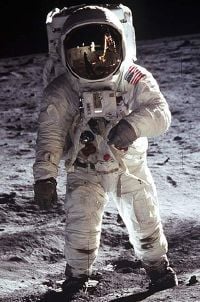
- For more details on this topic, see Science and Technology.
Science is the discovery of knowledge about the world by verifiable means. Technology is the objects humans make to serve their purposes.
Human cultures are both characterized and differentiated by the objects that they make and use. Archeology attempts to tell the story of past or lost cultures in part by close examination of the artifacts they produced. Early humans left stone tools, pottery, and jewelry that are particular to various regions and times.
Improvements in technology are passed from one culture to another. For instance, the cultivation of crops arose in several different locations, but quickly spread to be an almost ubiquitous feature of human life. Similarly, advances in weapons, architecture, and metallurgy are quickly disseminated.
Such techniques can be passed on by oral tradition. The development of writing, itself a kind of technology, made it possible to pass information from generation to generation and from region to region with greater accuracy.
Together, these developments made possible the advance of civilization and urbanization, with their inherently complex social arrangements. Eventually, this led to the institutionalization of the development of new technology, and the associated understanding of the way the world functions. This science now forms a central part of human culture.
In recent times, physics and astrophysics have come to play a central role in shaping what is now known as physical cosmology, that is, the understanding of the universe through scientific observation and experiment. This discipline, which focuses on the universe as it exists on the largest scales and at the earliest times, begins by arguing for the big bang, a sort of cosmic expansion from which the universe itself is said to have erupted ~13.7 ± 0.2 billion (109) years ago. After its violent beginnings and until its very end, scientists then propose that the entire history of the universe has been an orderly progression governed by physical laws.
Society
- For more details on this topic, see Society.
Society is the system of organizations and institutions arising from interaction between humans.
Government and politics

- For more details on this topic, see Government, Politics, and State.
A state is an organized political community occupying a definite territory, having an organized government, and possessing internal and external sovereignty. Recognition of the state's claim to independence by other states, enabling it to enter into international agreements, is often important to the establishment of its statehood. The "state" can also be defined in terms of domestic conditions, specifically, as conceptualized by Max Weber, "a state is a human community that (successfully) claims the monopoly of the 'legitimate' use of physical force within a given territory" (Weber 1918).
Government can be defined as the political means of creating and enforcing laws, typically via a bureaucratic hierarchy.
Politics is the process by which decisions are made within groups. Although the term is generally applied to behavior within governments, politics is also observed in all human group interactions, including corporate, academic, and religious institutions. Many different political systems exist, as do many different ways of understanding them, and many definitions overlap. The most common form of government worldwide is a republic, however other examples include monarchy, social democracy, military dictatorship, and theocracy.
All of these issues have a direct relationship with economics.

War
- For more details on this topic, see War.
War is a state of widespread conflict between states, organizations, or relatively large groups of people, which is characterized by the use of lethal violence between combatants or upon civilians. It is estimated that during the twentieth century between 167 and 188 million humans died as a result of war (Ferguson 2006).
A common perception of war is a series of military campaigns between at least two opposing sides involving a dispute over sovereignty, territory, resources, religion or other issues. A war said to liberate an occupied country is sometimes characterized as a "war of liberation," while a war between internal elements of a state is a civil war. Full scale pitched-battle wars between adversaries of comparable strength appear to have nearly disappeared from human activity, with the last major one in the Congo region winding down in the late 1990s. Nearly all war now is asymmetric warfare, in which campaigns of sabotage, guerrilla warfare, and sometimes acts of terrorism disrupt control and supply of better-equipped forces, resulting in long, low-intensity wars of attrition.
There have been a wide variety of rapidly advancing tactics throughout the history of war, ranging from conventional war to asymmetric warfare to total war and unconventional warfare. Techniques include hand to hand combat, the use of ranged weapons, and ethnic cleansing. Military intelligence has often played a key role in determining victory and defeat. Propaganda, which often includes factual information, slanted opinion, and disinformation, plays a key role in maintaining unity within a warring group, and/or sowing discord among opponents. In modern warfare, soldiers and armored fighting vehicles are used to control the land, warships the sea, and air power the sky. Outer space has recently become a factor in warfare as well, although no actual warfare is currently carried out in space.
War is a strong catalyst in technology. Throughout history there has been a constant struggle between defense and offense, armor, and the weapons designed to breach it. Modern examples include the bunker buster bomb, and the bunkers which they are designed to destroy. Important inventions such as medicine, navigation, metallurgy, mass production, nuclear power, rocketry, and computers have been completely or partially driven by war.
Trade and economics

Trade is the voluntary exchange of goods, services, or both, and a form of economics. A mechanism that allows trade is called a market. The original form of trade was barter, the direct exchange of goods and services. Modern traders instead generally negotiate through a medium of exchange, such as money. As a result, buying can be separated from selling, or earning. The invention of money (and later credit, paper money, and non-physical money) greatly simplified and promoted trade.
Trade exists for many reasons. Because of specialization and division of labor, most people concentrate on a small aspect of manufacturing or service, trading their labor for products. Trade exists between regions because different regions have an absolute or comparative advantage in the production of some tradeable commodity, or because different regions' size allows for the benefits of mass production.
Economics is a social science that studies the production, distribution, trade, and consumption of goods and services.
Economics, which focuses on measurable variables, is broadly divided into two main branches: microeconomics, which deals with individual agents, such as households and businesses, and macroeconomics, which considers the economy as a whole, in which case it considers aggregate supply and demand for money, capital, and commodities. Aspects receiving particular attention in economics are resource allocation, production, distribution, trade, and competition. Economic logic is increasingly applied to any problem that involves choice under scarcity or determining economic value. Mainstream economics focuses on how prices reflect supply and demand, and uses equations to predict consequences of decisions.
ReferencesISBN links support NWE through referral fees
- Astner, S. and R. R. Anderson. 2004. Skin phototypes 2003. Journal of Investigative Dermatology 122. Retrieved July 13, 2020.
- Banton, M. 1977. The Idea of Race. Boulder, CO: Westview Press. ISBN 0891587195.
- Benthall, J. 2007. Animal liberation and rights. Anthropology Today 23(2): 1-3.
- Block, 1995. On a confusion about a function of consciousness. Behavioral and Brain Sciences 18(2): 227-287.
- Boyd, R., and J. B. Silk. 2003. How Humans Evolved. New York: Norton & Company. ISBN 0393978540.
- Buss, D. M. 2003. The Evolution of Desire: Strategies of Human Mating. New York: Basic Books. ISBN 046500802X.
- Chimpanzee Sequencing and Analysis Consortium. 2005. Initial sequence of the chimpanzee genome and comparison with the human genome. Nature 437: 69–87.
- Correia, H., S. Balseiro, and M. De Areia. 2005. Sexual dimorphism in the human pelvis: Testing a new hypothesis Homo 56(2): 153-160. Retrieved July 13, 2020.
- Coveney, D. 2001. Researchers home in on how brain handles abstract thought. Massachusetts Institute of Technology. Retrieved July 13, 2020.
- de Beer, H. 2004. Observations on the history of Dutch physical stature from the late-Middle Ages to the present Econ Hum Biol 2(1): 45-55. Retrieved July 13, 2020.
- Dennett, D. 1991. Consciousness Explained. Little Brown & Co. ISBN 0316180653.
- Disotell, T. R. 1999. Human evolution: Origins of modern humans still look recent Current Biology 9(17): R647-R650. Retrieved July 13, 2020.
- Dobzhansky, T. 1963. Anthropology and the natural sciences: The problem of human evolution. Current Anthropology 4(2): 138-148.
- Ebersberger, I., D. Metzler, C. Schwarz, and S. Paabo. 2002. Genomewide comparison of DNA sequences between humans and chimpanzees. American Journal of Human Genetics 70: 1490–97.
- Ferguson, N. 2006. The next war of the world. Foreign Affairs Sep/Oct 2006. Retrieved July 13, 2020.
- Goodman, M., D. Tagle, D. Fitch, W. Bailey, J. Czelusniak, B. Koop, P. Benson, and J. Slightom. 1990. Primate evolution at the DNA level and a classification of hominoids J Mol Evol 30(3): 260 -266. Retrieved July 13, 2020.
- Harding, R. M., E. Healy, A. J. Ray, N. S. Ellis, N. Flanagan, C. Todd, C. Dixon, A. Sajantila, I. J. Jackson, M. A. Birch-Machin, and J. L. Rees. 2000. Evidence for variable selective pressures at MC1R. American Journal of Human Genetics 66: 1351–1361.
- Jablonski, N. G., and G. Chaplin. 2000. The evolution of human skin coloration. Journal of Human Evolution 39: 57-106. Retrieved July 13, 2020.
- Keita, S. O. Y., R. A. Kittles, C. D. M. Royal, G. E. Bonney, P. Furbert-Harris, G. M. Dunston, and C. N. Rotimi. 2004. Conceptualizing human variation. Nature Genetics 36: S17 - S20. Retrieved July 13, 2020.
- Khor, G. 2003. Update on the prevalence of malnutrition among children in Asia Nepal Med Coll J 5(2): 113-122. Retrieved July 13, 2020.
- LaVelle, M. 1995. Natural selection and developmental sexual variation in the human pelvis Am J Phys Anthropol 98(1): 59-72. Retrieved July 13, 2020.
- Lewontin, R. D. 1973. The apportionment of human diversity. Evolutionary Biology 6: 381-397.
- Liu, G., NISC Comparative Sequencing Program, S. Zhao, J. A. Bailey, S. C. Sahinalp, C. Alkan, E. Tuzun, E. D. Green, and E. E. Eichler. 2003. Analysis of primate genomic variation reveals a repeat-driven expansion of the human genome. Genome Research 13: 358–68.
- Mayr, E. 2001. What Evolution Is. New York: Basic Books. ISBN 0465044263.
- Murray, C., and A. Lopez. 1997. Global mortality, disability, and the contribution of risk factors: Global Burden of Disease Study Lancet 349(9063): 1436-1442. Retrievevd July 13, 2020.
- Nielsen, R., C. Bustamante, A. G. Clark, S. Glanowski, T. B. Sackton, M. J. Hubisz, A. Fiedel-Alon, D. M. Tanenbaum, D. Civello, T. J. White, J. J. Sninsky, M. D. Adams, and M. Cargill. 2005. A scan for positively selected genes in the genomes of humans and chimpanzees. PLoS Biology 3(6): e170.
- O'Campo, P. 2001. Race. In C. Blakemore and S. Jennett, The Oxford Companion to the Body. New York: Oxford University Press. ISBN 019852403X.
- Palmer, J. 2006. Consciousness and the symbolic universe. The University of Louisiana at Monroe. Retrieved July 13, 2020.
- Physorg. 2005. Scientists narrow time limits for human, chimp split. Physorg.com. Retrieved July 13, 2020.
- Plotnik, J. M., F. B. de Waal, and D. Reiss. 2006. Self-recognition in an Asian elephant. Proc Natl Acad Sci U S A 103(45): 17053-17057. Retrieved July 13, 2020.
- Public Broadcasting Service (PBS). 2005. The secret life of the brain: 3-D brain anatomy. Public Broadcasting Service. Retrieved July 13, 2020.
- Risch, N., E. Burchard, E. Ziv, and H. Tang. 2002. Categorization of humans in biomedical research: Genes, race and disease. Genome Biol 3. Retrieved July 13, 2020.
- Robins, A. 1991. Biological Perspectives on Human Pigmentation. Cambridge: Cambridge University Press. ISBN 0521365147.
- Rogers, A. R., D. Iltis, and S. Wooding. 2004. Genetic variation at the MC1R locus and the time since loss of human body hair. Current Anthropology 45(1): 105-108.
- Ruse, M., and J. Travis (eds.). 2009. Evolution: The First Four Billion Years. Belknap Press. ISBN 978-0674031753
- Rush, D. 2000. Nutrition and maternal mortality in the developing world Am J Clin Nutr 72(1 Suppl): S212-S240. Retrieved July 13, 2020.
- Sagan, C. 1978. The Dragons of Eden. Ballantine. ISBN 0345346297.
- Schwartz, M., and J. Vissing. 2002. Paternal inheritance of Mitochondrial DNA. N Engl J Med 347: 576-580.
- Smedley, A. 1999. Race in North America: Origin and Evolution of a Worldview, 2nd ed. Boulder CO: Westview Press, Boulder. ISBN 0813334489.
- Stepler, R. 2016. World’s centenarian population projected to grow eightfold by 2050 Pew Research Center. Retrieved July 13, 2020.
- Thornhill, R., and C. T. Palmer. 2000. A Natural History of Rape. Biological Bases of Sexual Coercion. Cambridge: MIT Press. ISBN 0585082006.
- VandenBos, G. R. (ed.). 2007. APA Dictionary of Psychology. Washington, DC: American Psychological Association. ISBN 978-1591473800.
- Wade, N. 2003. Why humans and their fur parted ways. New York Times August 19, 2003. Retrieved July 13, 2020.
- Weber, M. 1918. Politics as a vocation. Retrieved July 13, 2020.
- Wells, J. 2000. Icons of Evolution. Washington, DC: Regnery Publishing. ISBN 0895262762.
- Wildman, D. E., M. Uddin, G. Liu, L. I. Grossman, and M. Goodman. 2003. Implications of natural selection in shaping 99.4 percent nonsynonymous DNA identity between humans and chimpanzees: Enlarging genus Homo. Proceedings of the National Academy of Sciences 100: 7181–88.
- Wood, T. C. 2006. The chimpanzee genome and the problem of biological similarity. Occasional Papers of the BSG 7: 1–18. Retrieved July 13, 2020.
| |||||
Sahelanthropus tchadensis • Orrorin tugenensis • Ardipithecus
Australopithecus: A. anamensis • A. afarensis • A. bahrelghazali • A. africanus • A. garhi
Paranthropus: P. aethiopicus • P. boisei • P. robustus
Kenyanthropus platyops
Homo: H. habilis • H. rudolfensis • H. georgicus • H. ergaster • H. erectus (H. e. lantianensis • H. e. palaeojavanicus • H. e. pekinensis • H. e. soloensis) • H. cepranensis • H. antecessor • H. heidelbergensis • H. neanderthalensis • H. rhodesiensis • H. floresiensis • Homo sapiens (H. s. idaltu • H. s. sapiens)
| ||||||||||||||||||||||
Credits
New World Encyclopedia writers and editors rewrote and completed the Wikipedia article in accordance with New World Encyclopedia standards. This article abides by terms of the Creative Commons CC-by-sa 3.0 License (CC-by-sa), which may be used and disseminated with proper attribution. Credit is due under the terms of this license that can reference both the New World Encyclopedia contributors and the selfless volunteer contributors of the Wikimedia Foundation. To cite this article click here for a list of acceptable citing formats.The history of earlier contributions by wikipedians is accessible to researchers here:
The history of this article since it was imported to New World Encyclopedia:
Note: Some restrictions may apply to use of individual images which are separately licensed.
